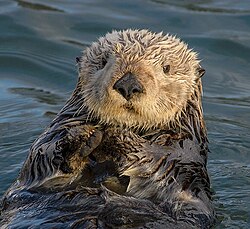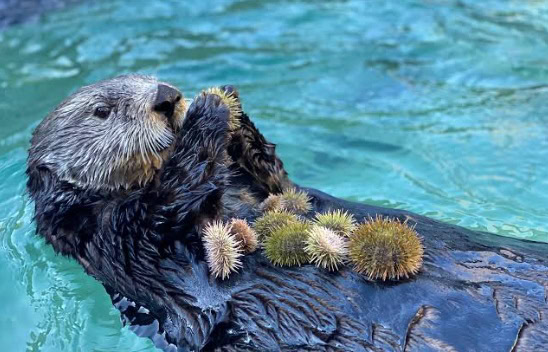
There are many types of otters in the world. Some live on land, some in freshwater, others in the sea. Some live in the Americas, others in Asia. However, only one species of otter is fully aquatic — Enhydra lutris. This is the species known as the sea otter.
Scientific names
Enhydra lutris has three subspecies that live in geographically separate populations:
- Enhydra lutris nereis — Southern sea otter or “California” sea otter; ranges in California from San Mateo County in the north to near Santa Barbara County in the south
- Enhydra lutris kenyoni — northern sea otter; found along the coast of Alaska and Washington
- Enhydra lutris lutris — Russian sea otters; found in the Pacific ocean off the coasts of Russia and Japan
Here at the Aquarium, our sea otters are southern, or California, sea otters. The most notable physical difference between this subspecies and its northern cousins is size. Whereas a female southern sea otter grows up to 50 pounds, a female northern sea otter can weigh up to 70 pounds. For males, the difference is also significant — a southern male grows up to 70 pounds while a northern male can reach up to 100 pounds!
Throughout this page, we will focus on the life and natural history of the southern sea otter specifically.
Habitat
In Monterey Bay, the sea otter lives in kelp forest and estuary habitats.
The sea otter is an important part of both of these habitats — It’s a keystone species, which means that the health of sea otters is a good indication of the health of other species and ecosystems nearby.
In the kelp forest, it eats sea urchins and other animals that graze on giant kelp. When urchins go unchecked, they create areas called “urchin barrens” where nothing else lives. With sea otters helping to keep the urchins under control, kelp forests can thrive and support a rich community of plants and animals.
Similarly, in estuaries, otters keep eelgrass healthy by eating crabs, which in turn allows the sea slug population to thrive. These sea slugs then eat algae that would otherwise coat and smother the eelgrass that fish need for food and shelter.
What do sea otters eat?
The southern sea otter eats invertebrates like crabs, snails, urchins, clams, abalone, and mussels — for breakfast, lunch, dinner, and between-meal snacks! Northern sea otters are also known to eat fish.
A sea otter may hunt on the seafloor but always returns to the surface to eat. Floating there on its back, it uses its chest as a table. (And if dinner is a crab or clam, the otter may use a rock to crack open its prey.)
Do you ever carry a snack for later? An otter does, too! An otter’s coat has pockets — loose skin under each forearm. An otter uses them to stash prey during a dive, which leaves its paws free to hunt some more.
Size
The southern sea otter is the smallest marine mammal in North America at up to 4 feet (1.2 m) long and up to 50 pounds (23 kg) for females and 70 pounds (32 kg) for males. South America’s marine otter — Lontra felina — is the smallest marine mammal in the world.
Population
The current southern sea otter population averages around 3,000 individuals. Since the California population has a limited range and is close to human activity, they are considered endangered.
Fur
Unlike other marine mammals, the sea otter doesn’t have a thick layer of blubber. To stay warm in chilly ocean waters, it wears the world’s densest fur — at its thickest, this two-layer fur is made up of more than a million hairs per square inch. For reference, you’ve probably got 100,000 hairs or less on your whole head!
Grooming
To keep its luxurious coat waterproof, an otter spends many hours a day cleaning and grooming. Such good grooming coats its fur with natural oils from their skin and fluffs it with insulating air bubbles.
Metabolism
Another way the sea otter stays warm is with its high metabolism — it will eat about a quarter of its body weight each day (A 150-pound person would have to eat 35 to 40 pounds of food a day to match that). This helps it maintain an average body temperature of 100 degrees Fahrenheit!
Sea otters and humans
A sea otter, as cute as it is, should not be approached by humans. If you encounter a sea otter in the wild, even if one approaches you, maintain your distance! A sea otter is a wild animal — maintaining a safe distance is the safest for both you and the otter.
If you encounter live or dead stranded sea otter, please report it to the appropriate organization. Visit seaottersavvy.org to learn more about co-existing with sea otters.
Publish Date
August 12, 2025
Post Type
- Sea Creatures
Topic
- Fur
Author(s)
Related Articles
Lorem ipsum dolor sit amet, consectetur adipiscing elit ut aliquam, purus sit amet luctus venenatis, lectus magna fringilla urna, porttitor rhoncus dolor purus non
Lions – test post
We’ve all heard of someone trying to hide a pregnancy; the entire…
Penguins – test post
Penguins are fascinating flightless birds, primarily found in the Southern Hemisphere, with…


